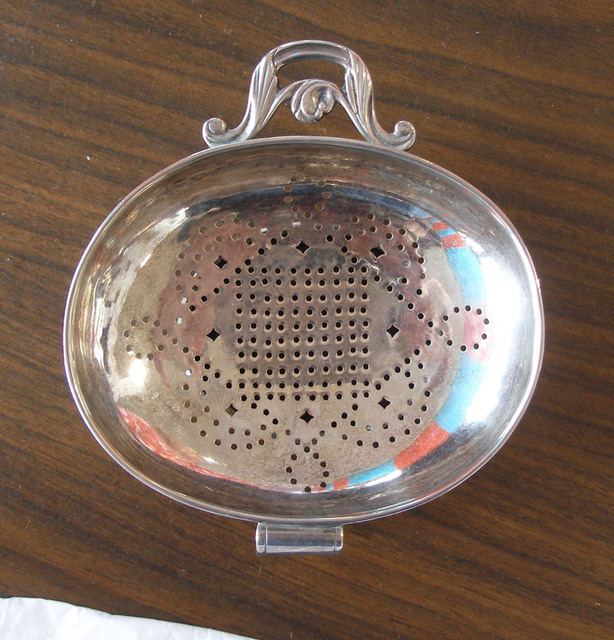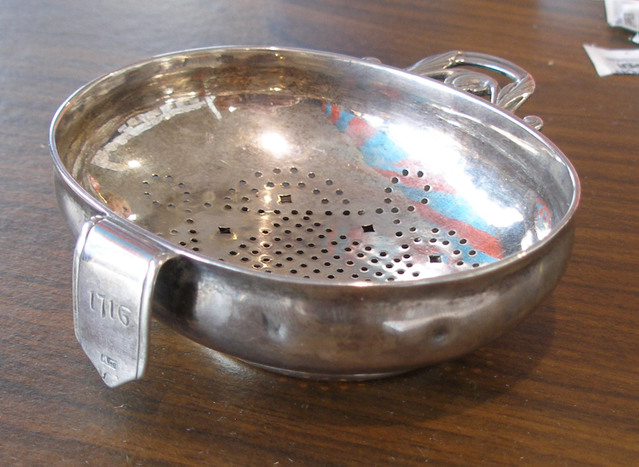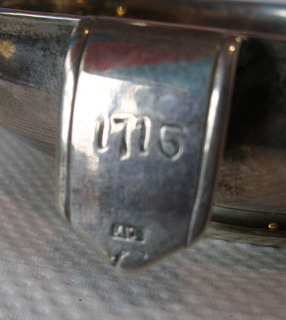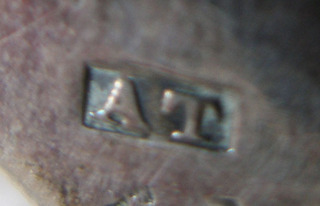|
A GLOSSARY of MILLED BANDS
|
|
| How to Post Photos |
REGISTER (click here)
|
|
A GLOSSARY of MILLED BANDS
|
|
| How to Post Photos |
REGISTER (click here)
|

|
 SMP Silver Salon Forums SMP Silver Salon Forums
  American Silver before sterling American Silver before sterling
  Punch strainer Punch strainer
|
| next newest topic | next oldest topic |
| Author | Topic: Punch strainer |
|
ahwt Posts: 2334 |
  
    I saw a friend and great collector in Atlanta recently and he showed me one of his latest finds - the above strainer. The clip of the strainer is marked with the number 1716 and the initials AT within a rectangle. I could find no other markings on the strainer. The pierced pattern is not quite centered in the bowl of the strainer, perhaps indicating that someone still learning their craft may have made the strainer. I suspect that the piercing is accomplished before the raising operation and that this may account for difficultly in centering the pattern on the finished bowl. I have had little experience in examining early 18th century American silver (actually no experience) but it seems to me that the strainer handle contains design elements similar to the design elements in the handle on the Edward Winslow sugar box shown on page 64 of Patricia Kane's book. This sugar box is ca. 1702 and while Ms. Kane seems to suggest that by 1716 this design would no longer have been used by Boston silversmiths perhaps not all elements of the past would have been discarded by a young silversmith. Ms. Fales in her book "Early American Silver" states that punch strainers were introduced into American silver in the mid-eighteenth century. Ian M. G. Quimby in his book "American Silver at Winterthur" shows two early or mid 18th century strainers - one ca. 1750 by Samuel and Thomas Edwards of Boston on page 102 and a second by Bartholomew Le Roux I on page 261 ca. 1730. If the above strainer was made by Andrew Tyler in 1716 it may be the first example of an American strainer. Any ideas or suggestions about this possible attribution would be appreciated. IP: Logged |
|
argentum1 Posts: 602 |
  
The handle appears,at least to me, to be of a more recent design than would be seen on an early 18th century silver strainer. Engraved dates are always suspect as to when the actual engraving was done and for what reason. It will be interesting to find out what others have to say. IP: Logged |
|
agphile Posts: 798 |
  
It may not be very helpful to offer comment from England, but this does look rather different from the early 18th century English strainers I have seen. They normally have circular bowls and lack a foot on which to stand when not in use. And I agree with Argentum 1 that the handle looks out of period. I wonder whether this started life as something else and has been altered? However, I have never made any sort of study of strainers that would allow me to know what variant designs might exist and I suppose a one-off made in America might not necessarily follow English styles. IP: Logged |
|
vathek Posts: 966 |
  
I did some searching on strainers (tea, lemon, punch)and could find nothing with this configuration. Is it possibly an altered wine funnel strainer? IP: Logged |
|
swarter Moderator Posts: 2920 |
  
The plain initial mark shown in Kane (also in Buhler & Hood / MFA) is only found on spoons and a ring, not on hollow ware items; more significantly that mark is not the same as the one on the strainer, having the letters closer together, and the punch less elongated. It should also be noted that the LeRoux example, which has a "hook" on one side, lacks a handle on the other. On first glance, it has to be considered that the strainer might have been modified from a porringer, with the punching and another piece from something else added to serve as a "hook." Clayton"s "Collector"s Dictionary, however," describes and illustrates somewhat similar forms from late 17th and 18th C England, especially Exeter and also Scotland, so there is no compelling reason to assume this piece, if indeed it is original, is necessarily American. IP: Logged |
|
ahwt Posts: 2334 |
  
Thank you for all your comments. I think Swarter was right and the mark on the “AT strainer” should not be attributed to Andrew Tyler. I did find some information about strainers in general that should be of interest. The book “Silver of the Americas, 1600-2000 – American Silver in the Museum of Fine Arts, Boston” edited by Jeannine Falino and Gerald W.R. Ward has the best explanation of the evolution of orange/punch strainers that I have found. Their explanation, at least in part, is based on an article by G. Bernard Hughes, entitled “Evolution of the Orange Strainer” published in Country Life (May 9, 1968). The editors note that orange strainers were used in England as early as 1533 and were used to catch the seeds of oranges as they were squeezed to produce juice for punch. It was the scarcity of oranges in England at this early date that may account for the special name given to this early form of strainer. The name evolved into punch strainer as time went by due to the popularity of this form of beverage, the increased availability of oranges and the use of other citrus fruits in punch. Early strainers resembled large spoons with pierced bowls and had a hook opposite the handle for securing the strainer to one side of a punch bowl. The oranges were squeezed over the strainer thereby allowing the juice to flow into the bowl while collecting the seeds in the strainer. As time went by two handle strainers were made to allow the strainer to rest on the punch bowl rim. Most bowls were pierced with a simple pattern of holes, but the piercing evolved into elaborately pierced decorative patterns. The authors suggest that the more decorative strainers were an enjoyment to the guests as they were waiting to be served. What better way to emphasize the ceremonial nature of serving punch. Below are two strainers shown in the book “The Albert Collection” by Robin Butler. Seven strainers are shown in this book (by far the most I found in any book) and two of them have a hook to allow hanging or resting one end on the rim of a bowl. The first has the makers mark for Epaphroditus Fowler, but no hallmarks. Robin Butler places this strainer as c. 1710. The second strainer has London assay marks and is from 1762. The makers mark WC is struck over another mark. This one is the only strainer, in the books I have, that has an oval bowl – as does the “AT strainer”. The oval bowl used in this strainer is certainly support that the “AT strainer” started its life as a strainer and was not converted from another object. Also the late date of 1762 would indicate that strainers with hooks did not disappear and is evidence that use of a hook does not necessarily date the strainer. I am no further in identifying the mark on the “AT strainer”, but it does seem to me that in view of prior documented strainers using oval bowls and the long use of hooks there is little reason to doubt that the “AT strainer” started its life as an orange/punch strainer. In view of the simply nature of the strainer I suspect that it was made in a provincial setting, and perhaps in one of the English colonies. IP: Logged |
|
agphile Posts: 798 |
  
Very interesting. I kick myself for not checking out the Albert collection as I have the book on my shelves and in fact viewed the collection when it was on display at the time the book was launched. I probably concentrated on other items and the strainers did not register in my memory. If I wanted to nitpick I would still wonder about the style of the handle and what looks like a footrim, but you are right that there seems to have been sufficient variety in the detail of the early strainers to accept such differences. I have come round to agreeing that this looks an interesting early piece though possibly not as early as the inscribed date/number: I note that the Albert oval strainer is from 1762. However, I would not take that comparison as a reason for insisting on a later date. IP: Logged |
|
ahwt Posts: 2334 |
  
After looking at Michael Adams’s book on Silver Lemon Strainers 1686-1846 I thought it would be interesting to revisit this post. This strainer, because of it rimmed base and small handle, would most likely fit in Michael’s section on the “conversions from another use”. I did not see one lemon strainer that had rimed base in his book, but this type of base was often used on quaiches from Scotland. The single handle on this piece also does not appear to be like those used on lemon strainers as it really seems too small for that grouping. It is true that quaiches normally started with two handles, but the hook may simple be a replacement for a damaged handle. I think this strainer marked with the letters AT could well have started as a drinking vessel and been converted to a strainer. If it was converted because of damage I would today call it a “make do” and that category for some collectors often adds value. [This message has been edited by Scott Martin (edited 05-17-2021).] IP: Logged |
All times are ET | next newest topic | next oldest topic |
  |
|
Ultimate Bulletin Board 5.46a
|
1. Public Silver Forums (open Free membership) - anyone with a valid e-mail address may register. Once you have received your Silver Salon Forum password, and then if you abide by the Silver Salon Forum Guidelines, you may start a thread or post a reply in the New Members' Forum. New Members who show a continued willingness to participate, to completely read and abide by the Guidelines will be allowed to post to the Member Public Forums. 2. Private Silver Salon Forums (invitational or $ donation membership) - The Private Silver Salon Forums require registration and special authorization to view, search, start a thread or to post a reply. Special authorization can be obtained in one of several ways: by Invitation; Annual $ Donation; or via Special Limited Membership. For more details click here (under development). 3. Administrative/Special Private Forums (special membership required) - These forums are reserved for special subjects or administrative discussion. These forums are not open to the public and require special authorization to view or post. |
|
copyright © 1993 - 2022
SM Publications
All Rights Reserved. Legal & Privacy Notices |